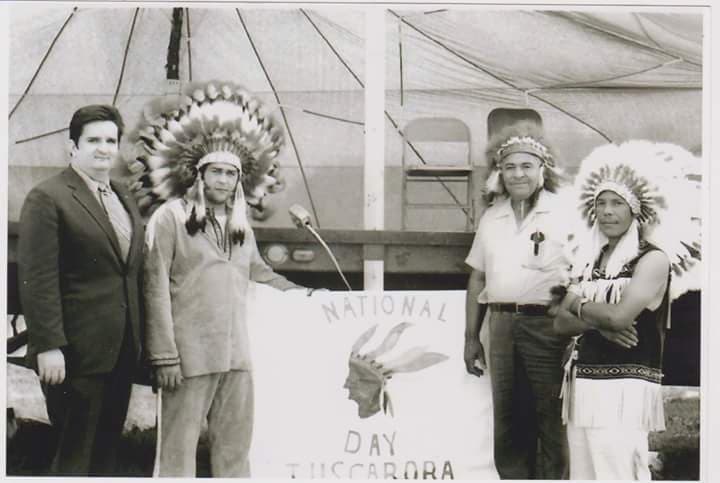Guest Post: Hiding in the Robeson County Swamps, Neuse River Tuscarora Settlements Remain in North Carolina Following Indian Removal
The following is a guest post from Donnie Rahnàwakęw McDowell, the Public Relations Officer at the Tuscarora Nation of North Carolina. If you would like to submit community content for The Cary Report, please use our contact form.
The Neuse River flows from the Carolina Piedmont in Durham County and transcends southeasterly through a half dozen other Carolina counties to empty into the Pamlico Sound. These major cities and townships include Raleigh, Cary, Smithfield, Goldsboro, Rocky Mount, Kinston, and New Bern. The unique and distinct history of the Neuse River is intimately connected with that of the Tuscarora Nation of North Carolina and other Native Americans. Prior to European colonization, multiple aboriginal nations lived along the tributaries of the Neuse River basins. The largest, strongest, and most influential was that of the Tuscarora Nation whose villages clustered along the Neuse River. When Indian Removal became imminent upon the Tuscarora Reservation in eastern NC, remaining Tuscarora families made their way to Robeson County Tuscarora settlements that took root almost a century prior.
Thousands of years before white settlement, the ancestors of the Tuscarora Nation of North Carolina controlled the land and resources surrounding the Neuse River. Upon encroachment by Europeans, the villages of the Tuscarora Confederacy across the region continued to acknowledge each other and work together to protect the interests of the Tuscarora communities. Spanish encounters in the 1520s identified a principal Tuscarora village, Torhunta. Expeditions led by Spanish explorers denote that travel was made up what is today the Tar River, a tributary of the Neuse and Pamlico rivers. Rivalries between the Spanish and English empires paralleled interactions with aboriginal nations in the Carolinas following colonial expeditions for resources and permanent settlement. War between Spain and Britain fueled divisions in their establishments fortified in the colonial frontier, influencing nations such as the Tuscarora to choose sides and fortify alliances.
Before the first attempts at permanent settlement by the English, Tuscarora communities hunted buffalo in what is today Cary and Raleigh. In the later part of the 17th century, John Lederer encountered the ancestors of the Tuscarora in what today would be Raleigh. With his narrative, Lederer explains that Kateras, a place of great trade, was controlled by the Tuscarora villages throughout the region. By the time of the first permanent European settlements along the Neuse, the Tuscarora Nation had already expanded their hegemony across regions decimated by disease or abandoned by tribes fleeing colonial warfare. Records indicate that the Tuscarora had a Spanish merchant and his family living among the Tuscarora communities. Historians generally deduce that due to Spanish intervention the Tuscarora operated as spies on the English settlement at Jamestown. Earlier attempts at permanent settlement at the Carolina coast exemplify that the Tuscarora were aware of English actions to colonize the region. Ironically enough, when conditions became too sour, Torhunta, a southern Tuscarora village, became a target for human trafficking, resource extraction, and English settlement. Accounts speculate that the Tuscarora and other American Indians had removed from Wake County by 1737.
The removal of Tuscarora villages, capture, and enslavement of Tuscarora citizens, and the seizure of Tuscarora lands left the leaders of the southern Tuscarora villages little choice but to act in resistance to continued colonial encroachment. After a series of wars along the Neuse, Pamlico, and Cape Fear Rivers, the Tuscarora Nation finally made peace with NC settlers through multiple treaties. Of the eight or nine northern Tuscarora villages that conducted peace with the English colonies of NC and Virginia, Torhunta mysteriously appeared. The protection offered by the Tuscarora treaties eventually aided in the establishment of the Indian Woods reservation which would be illegally closed and sold in the 1830s. Even though the NC State Assembly closed the Tuscarora Indian Woods reservation, this action was not successful in influencing the entirety of Tuscarora families that remained to remove themselves from the state. As a matter of fact, a Robeson County record from 1840 remarks that free families from the Roanoke and Neuse Rivers migrated to the swamps of Robeson County. Earlier settlements around the Drowning Creek in Robeson County welcomed the remaining Tuscarora families as they made their final exodus to find shelter among relatives. Evidence and testimony given by state officials who investigated the claims of the Henry Berry Lowry family in the mid to late 1800s verifies that Tuscarora families migrated to Robeson County to escape continued encroachment. Historian Dr. Peter Wood from Duke University has traced the migration patterns of a half dozen core Tuscarora families that migrated from eastern NC regions and settled in Robeson County.
Acknowledging the efforts and actions of the Tuscarora Nation from past to present, and their unique relationship to the Neuse River would be a means of effective and equitable reconciliation. That representation, in the ability to self-identify as Tuscarora and remain self-determined as Tuscarora communities, has continued to hinge on the reaffirmation of the TNNC by member tribes of the NC Commission of Indian Affairs. Despite acknowledging that the TNNC has maintained its relationship with the state since aboriginal times in communication with federal authorities in the late 1970s, the NC Indian Commission ignores the oppressed state of the Tuscarora People. Basic rights and privileges set aside for Indian tribes evade the TNNC at the direction of the NC Indian Commission. These programs, such as those organized and chartered by the recent NC American Indian Heritage Commission, ignore the sacrifices of the TNNC and oppose equitable representation of Tuscarora sacred and historical sites. Reaffirmation of the TNNC would create resources needed to protect and maintain the natural and scenic beauty of the Neuse River, while illuminating the historical importance of Tuscarora sites in relation to the TNNC and its communities that survived Indian Removal. With reaffirmation, the TNNC would be eligible to network with the NC Department of Natural and Cultural Resources to document previous habitation sites. This would include Tuscarora villages such as Kateras in Wake County, villages along the Neuse and other rivers, and documenting the Tuscarora migrations into Robeson County.




